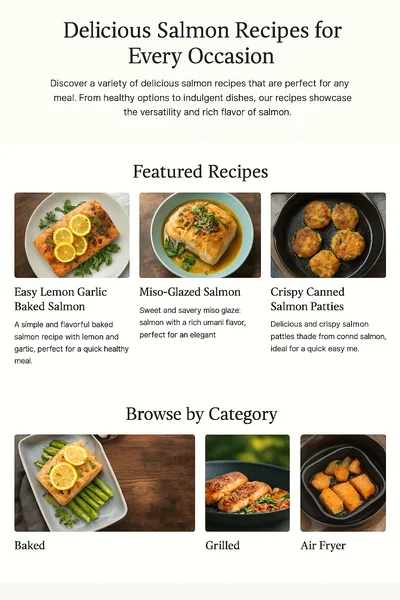Crispy Canned Salmon Patties

These golden salmon patties come together quickly using pantry staples and are pan-fried until crisp. A budget-friendly classic that transforms canned salmon into crispy, flavorful patties perfect for dinner or lunch. With their golden-brown crust and tender interior, these patties are comfort food at its finest and ready in just 25 minutes.
Ingredients
- 1 (15‑oz) can pink salmon, drained and flaked
- 1/4 cup finely diced onion
- 2 tablespoons chopped parsley
- 1 tablespoon lemon juice
- 1 large egg
- 1/2 cup breadcrumbs
- Salt and pepper, to taste
- 2 tablespoons vegetable oil
Instructions
- In a bowl combine the flaked salmon, onion, parsley, lemon juice, egg and breadcrumbs. Season with salt and pepper.
- Mix until just combined, then form into 6 small patties.
- Heat the oil in a skillet over medium heat. Cook the patties for 2–3 minutes per side until golden brown and crispy.
- Drain on a paper towel‑lined plate and serve warm with tartar sauce or a squeeze of lemon.
Equipment Needed
- Large mixing bowl
- Fork (for flaking salmon)
- Large skillet or frying pan
- Spatula
- Paper towels
- Plate for forming patties
Tips & Variations
- Drain well: Make sure to drain the canned salmon thoroughly and remove any large bones or skin if desired (though they're edible and nutritious).
- Don't overmix: Mix just until combined to keep the patties tender. Overmixing makes them tough.
- Chill for easier handling: Refrigerate formed patties for 15-30 minutes to help them hold together better during cooking.
- Use panko: Substitute regular breadcrumbs with panko for an extra crispy exterior.
- Add flavor: Mix in diced bell peppers, Old Bay seasoning, or dill for extra flavor variations.
- Bake option: For a healthier version, bake at 400°F (200°C) for 15-18 minutes, flipping halfway through.
Nutritional Information
Per serving (1.5 patties):
- Calories: 245
- Protein: 22g
- Fat: 12g (Saturated: 2g)
- Carbohydrates: 14g
- Fiber: 1g
- Omega-3 Fatty Acids: 1.2g
- Sodium: 520mg
- Calcium: 240mg (from salmon bones)
Canned salmon with bones provides excellent calcium. High in protein and budget-friendly omega-3s. A nutritious and economical meal option.
Storage & Reheating
Refrigerator: Store cooked patties in an airtight container for up to 3 days. Place parchment paper between layers to prevent sticking.
Freezer: Freeze cooked or uncooked patties for up to 3 months. Freeze on a baking sheet first, then transfer to a freezer bag. No need to thaw before cooking frozen uncooked patties.
Reheating: Reheat in a 350°F (175°C) oven for 10 minutes, or in a skillet over medium heat for 3-4 minutes per side to restore crispiness. Microwave at 70% power for 1-2 minutes, though this will soften the crust.
Make ahead: Form patties up to 24 hours in advance and refrigerate until ready to cook.
Serving Suggestions
Serve these salmon patties with:
- Sauces: Tartar sauce, remoulade, aioli, or lemon-dill sauce
- As a sandwich: On a bun with lettuce, tomato, and pickles
- Vegetables: Coleslaw, green beans, roasted vegetables, or corn on the cob
- Starches: Mashed potatoes, french fries, sweet potato fries, or rice
- Salads: Mixed green salad, potato salad, or cucumber salad
Recipe Notes
Canned salmon types: Pink salmon is more affordable and mild; sockeye or red salmon has richer flavor and deeper color. Both work well.
Binding issues: If the mixture is too wet, add more breadcrumbs. Too dry? Add another egg or a tablespoon of mayonnaise.
Size matters: Make smaller patties for appetizers or sliders, larger ones for main dishes. Adjust cooking time accordingly.
Keep bones: The soft bones in canned salmon are an excellent source of calcium and completely edible. Mash them in with a fork.
Budget tip: This recipe is perfect for stretching your food budget. Canned salmon is much more affordable than fresh.
Gluten-free option: Use crushed gluten-free crackers, almond flour, or gluten-free breadcrumbs instead of regular breadcrumbs.